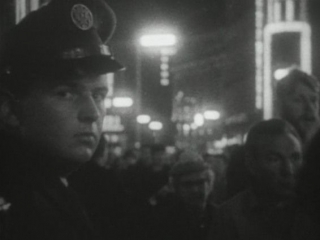Date: 30 May 2008 | Season: Videoex 2008
SOCIAL WORKS: NEW DOCUMENTARY FORMS
Friday 30 May 2008, at 4pm
Zurich Videoex Festival Cinema Z3
Long before the celebrated ‘Free Cinema’ movement of the 1950s, British-based filmmakers were advancing the documentary form through innovative styles and techniques. Beginning with a hilariously absurd travelogue from 1924, this programme traces that development through good times and bad, resolute with humour and irony.
Adrian Brunel, Crossing the Great Sagrada, 1924, 35mm, tinted b/w, sound, 10 min
Arthur Elton & E.H. Anstey, Housing Problems, 1935, 35mm, b/w, sound, 13 min
Stefan & Franciszka Themerson, Calling Mr Smith, 1943, 35mm, colour, sound, 10 min
Len Lye, N or NW, 1938, 35mm, b/w, sound, 8 min
Charles Ridley, Germany Calling, 1941, 16mm, b/w, sound, 2 min
Claude Goretta & Alan Tanner, Nice Time, 1957, 16mm, b/w, sound, 17 min
John Bennett, Papercity, 1969, 35mm, colour, sound, 5 minutes
PROGRAMME NOTES
SOCIAL WORKS: NEW DOCUMENTARY FORMS
Friday 30 May 2008, at 4pm
Zurich Videoex Festival Cinema Z3
CROSSING THE GREAT SAGRADA
Adrian Brunel, 1924, 35mm, tinted b/w, sound, 10 min
The film is a humorous spoof of a travelogue. Travel films were popular in the Twenties, documenting foreign cultures in a way that tended to reflect imperial, nationalist and often racist stereotypes. Brunel sends up many of the conventions of the genre familiar to audiences. (Jamie Sexton)
HOUSING PROBLEMS
Arthur Elton & Edgar Anstey, 1935, 35mm, b/w, sound, 13 min
A watershed in British documentary making. For the first time ordinary people spoke directly to the camera about their plight. The clumsy sound-recording equipment (packed into a truck parked outside the locations in Stepney) enabled the directors to achieve huge impact by filming the slum dwellers as they described life inside their wretched houses. The film was made to promote the use of gas as a clean and modern fuel by associating it with the throwing out of the old and the building of the new. (FourDocs)
CALLING MR SMITH
Stefan & Franciszka Themerson, 1943, 35mm, colour, sound, 10 min
The Themersons call on ‘Mr Smith’ to support the war effort as an anti-fascist struggle, illustrating its appeal with examples of Nazi oppression in Poland. The film is experimental in technique, using anamorphic lenses, still and moving images and vivid colour. While the spoken soundtrack employs a rhetoric heard elsewhere in wartime propaganda, the overall tone of the film is unusually urgent and authentic and in some sequences, images combine with music (Chopin, Szymanowski) to convey a real feeling of loss. (David Finch)
N or N.W.
Len Lye, 1938, 35mm, b/w, sound, 8 min
In N or N.W., Lye began to work with more conventionally ‘dramatic’ material. The film, advertising the benefits of writing letters and using the postal system, centred on a simple narrative of lovers at cross-purposes who are eventually reunited. Yet Lye used a number of unconventional edits, extreme close-ups, trick shots and superimposed animation in order to take a creative approach to such a conventional theme. (Jamie Sexton)
GERMANY CALLING
Charles Ridley, 1941, 35mm, b/w, sound, 2 min
A remarkable piece of British wartime propaganda which ridicules Nazi Germany by manipulating footage of Hitler, his party officials and troops of goose stepping soldiers. All are subjected to the optical humiliation of being made dance to the ‘The Lambeth Walk’, a song that the Nazi party branded as ‘Jewish mischief and animalistic hopping.’ (MW)
NICE TIME
Claude Goretta & Alan Tanner, 1957, 16mm, b/w, sound, 17 min
Impressions of Piccadilly Circus in 1957: hot dogs and nude magazines; dumb cinema queues; posters advertising the glories of war and the horrors of science fiction; lonely faces; searching glances; the parade of amateur and professional ‘talent’; presiding over all, the ironic statue of Eros … The observation is untouched by nostalgia, and presents a devastating picture for anyone who thinks of Piccadilly Circus in romantic terms. (Monthly Film Bulletin)
PAPERCITY
John Bennett, 1969, 35mm, colour, sound, 5 min
Papercity builds an impressionistic portrait of London through still photographs and time-lapse footage. Views of the city rarely feature in experimental films of this period, but this semi-commercial production, funded by the British Film Institute, is an evocative study of everyday sights and activities. (MW)
Back to top
